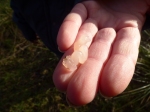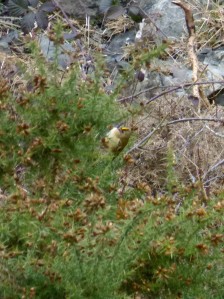Scilly Species Sightings
Last weekend was amazing. One of the best weekends in my life for sure. It was a long weekend, where ten women headed down to the Isles of Scilly to relax, drink wine and watch wildlife. This being a wildlife blog, I shall focus on the latter in this post, but I can reassure you that copious amounts of the first two also occurred. Each day on Scilly deserves its own blog post – in fact, each half of a day! But I shall keep it as short and concise as I can.
It was a false start to begin with, when I got very excited during boarding as I saw an Eider Duck (Somateria mollissima) in the Penzance harbour. The excitement was (a) it is a gorgeous duck, and (b) I thought it was lifer. When I got home, I realised that I have actually seen an Eider Duck before during the Scottish wildlife holiday last year. But still, it was very nice to see it. The sightings continued during the journey on the Scillonian across to the Scilly Isles – Gannet (Morus bassanus), Fulmar (Fulmarus glacialis), Great Northern Diver (Gavia immer), and most wonderfully – dolphins (Delphinus delphis)! We saw one playing in the waves created by the boat, only briefly mind, but gosh it was superb. Then not long after, I saw a pod of at least 8 in the distance, leaping into the air. There isn’t much in life that beats the thrill of watching wild dolphins.
Once we were on Scilly, I had the pleasant surprise of watching our usual garden birds on the seashore – House Sparrows (Passer domesticus), Robins (Erithacus rubecula) and Blackbirds (Turdus merula), searching amongst the seaweed for food. I suppose I shouldn’t have been surprised, but I was as I had never seen these birds on a sandy beach before! I even saw a Blackbird getting its feet wet – it didn’t seem to enjoy paddling as it quickly jumped out onto a rock!
The timing of our visit worked very well in coinciding with the very low spring tides, and we were able to walk from Tresco to Bryher (after seeing the Iberian Chiffchaff, Phylloscopus ibericus, and feeding crisps to the Golden Pheasants, Chrysolophus pictus). I had great fun rockpooling between the islands, finding the cast-off shells of crabs, peeking in at Hermit Crabs (Pagurus bernhardus) and generally poking around in the seaweed. At one point I almost died (well, not quite, but it makes it more dramatic), as I found a Short-spined Scorpion Fish (Myoxocephalus scorpius) stranded on the sand and moved it back into the water. Fortunately I picked it up by its tail, as it was only afterwards that I found out that they have venomous barbs which can cause swelling and pain! Yikes!
On Bryher, we had one thing in mind. The Snowy Owl (Bubo scandiacus)! And what a beauty it was. Though I have to admit, I didn’t realise where it was at first. When I first looked through my binoculars at it, its face was turned away and honestly, it looked exactly like a big white rock. I felt like such a bad birder when I had to have someone tell me that actually, the big white rock was the Snowy Owl – oops! Once it turned its face back towards us, it definitely looked like an owl again thankfully. I have some awful distance photos of it which don’t really do it justice sadly.
After the Snowy Owl trip, we headed out on the Sapphire boat to find some seabirds (and to drink Prosecco). There were Razorbills (Alca torda), Guillemots (Uria aalge), Shags (Phalacrocorax aristotelis) and more Great Northern Divers and Gannets. My avian highlight had to be the Puffins (Fratercula arctica)! I’ve only ever seen dead ones, having worked on Chesil Beach just after the big winter storms in January / February 2014 and found plenty of dead birds on the beach. So I was overjoyed to actually see a live one, happily bobbing on the water. We also saw Grey Seals (Halichoerus grypus), which were great fun to watch as they would pop their heads up out of the water and then disappear again, only to resurface in a different spot.
One of the most hilarious moments of the trip came on Sunday afternoon. We’d had a nice relaxed walk in the drizzle, clambering through muddy woodlands and up hills to find the best apple strudel. By the way, I can confirm that it is the best apple strudel I’ve ever eaten. However, strudel / tea / beer was abandoned mid-bite / drink when Lucy shouted incoherently and ran out the cafe. Beth and I followed, somewhat confused but knowing it must be a good bird. And swooping over the fields, was a Harrier bird. Even distantly and without my binoculars (why didn’t I have my bins?!), I could see a nice white patch on it (ruling out Marsh Harrier, Circus aeruginosus), and very long and pointed elegant wings (apparently ruling out Hen Harrier? C.cyaneus). Lucy called it in as being a Montagu’s Harrier (C.pygargus) – my first!
I’ve not yet mentioned insects, and that’s because it wasn’t a good weekend for them. The drizzle and chill meant the only the most industrious were out and about, the bumblebees buzzing about the flowers. I had hauled my moth trap all the way down there, and despite the low numbers of moths caught, I was quite happy. It was better than the (non-existant) hauls I was catching at home, and there were even (at least) two new species for me: Marbled Coronet (Hadena confusa) and Chamomile Shark (Cucullia chamomillae). I say ‘at least’ because there were a couple of micros that I haven’t identified yet, which may turn out to be lifers for me.
It would be wrong to leave out the dipping*. I didn’t manage to see a Red-rumped Swallow (Cecropis daurica), and when we got back to Cornwall, we tried to see the Dalmatian Pelican (Pelecanus crispus) but we didn’t see it sadly. The twitchers in the group were rather gripped** by others seeing it earlier in the day. However I have to admit that by that point, I was absolutely shattered and worried about getting home too late, so I was less gripped.
Despite writing over 1000 words, I really have only laid out the bare bones of the trip. I haven’t mentioned the superb glamping experience at Peninnis Farm (really not anything like camping at all!), the stunning landscapes, the scrumptious food, the cute cats and dogs that I met (there were a few in particular that I absolutely fell in love with), and the wildflowers that I have been attempting to identify. But I’m sure you get the gist – it was amazing and wonderful, and I want to go back!
*dipping is when you go to twitch/see a bird (or other wildlife) and don’t see it
*gripped off is when someone has seen a bird and you haven’t, and you get rather jealous/annoyed/frustrated






























































































































































